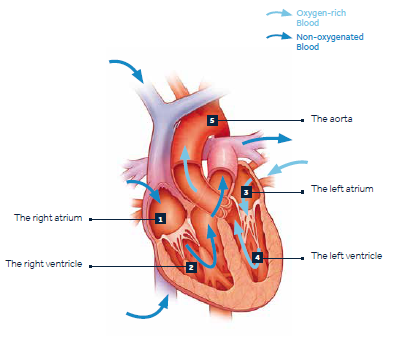
THE HEART
The heart is a fist-sized organ that acts as a pump to send oxygen-rich blood throughout the body. Regular, rhythmic electrical signals keep the heart pumping blood. The heart has four chambers:
-
Two upper chambers – a right atrium and a left atrium
-
Two lower chambers – a right ventricle and a left ventricle
The right atrium (1) takes in oxygen-depleted blood from the rest of the body and pushes it to the right ventricle (2) which then sends it to the lungs. The lungs oxygenate the blood which travels to the left atrium (3), and then onto the left ventricle (4), which pumps oxygen-rich blood to the rest of the body via the aorta (5).

What are heartbeats?
Heart rate is the number of times our heart beats within a certain period, usually one minute. Our body automatically controls our heart rate to match whatever we are doing or happening around us.
How many pulses should we have?
The resting heart rate i.e. when we are not moving but in a state of relaxation, for people aged 10 years and older, is 60 to 100 beats per minute(bpm).
This can be different in athletes who are in excellent physical condition, with pulses even dropping to 40 per minute!

